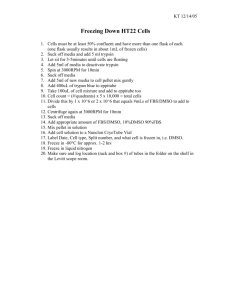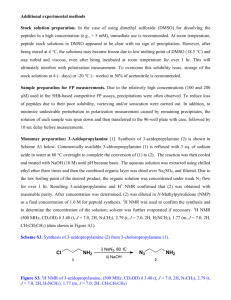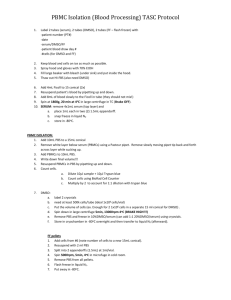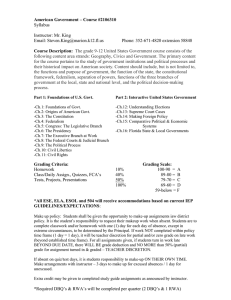Easy Access to Diastereomerically Pure Platinacycles Containing
advertisement
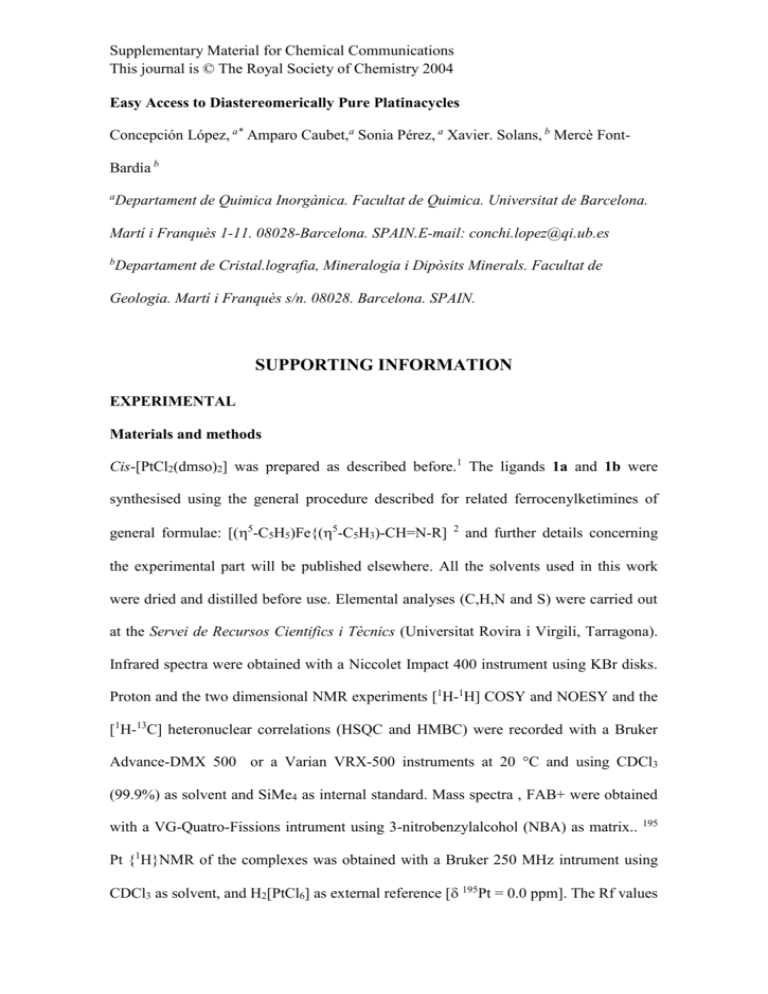
Supplementary Material for Chemical Communications
This journal is © The Royal Society of Chemistry 2004
Easy Access to Diastereomerically Pure Platinacycles
Concepción López, a* Amparo Caubet,a Sonia Pérez, a Xavier. Solans, b Mercè FontBardía b
a
Departament de Quimica Inorgànica. Facultat de Quimica. Universitat de Barcelona.
Martí i Franquès 1-11. 08028-Barcelona. SPAIN.E-mail: conchi.lopez@qi.ub.es
b
Departament de Cristal.lografia, Mineralogia i Dipòsits Minerals. Facultat de
Geologia. Martí i Franquès s/n. 08028. Barcelona. SPAIN.
SUPPORTING INFORMATION
EXPERIMENTAL
Materials and methods
Cis-[PtCl2(dmso)2] was prepared as described before.1 The ligands 1a and 1b were
synthesised using the general procedure described for related ferrocenylketimines of
general formulae: [(5-C5H5)Fe{(5-C5H3)-CH=N-R]
2
and further details concerning
the experimental part will be published elsewhere. All the solvents used in this work
were dried and distilled before use. Elemental analyses (C,H,N and S) were carried out
at the Servei de Recursos Cientifics i Tècnics (Universitat Rovira i Virgili, Tarragona).
Infrared spectra were obtained with a Niccolet Impact 400 instrument using KBr disks.
Proton and the two dimensional NMR experiments [1H-1H] COSY and NOESY and the
[1H-13C] heteronuclear correlations (HSQC and HMBC) were recorded with a Bruker
Advance-DMX 500 or a Varian VRX-500 instruments at 20 °C and using CDCl3
(99.9%) as solvent and SiMe4 as internal standard. Mass spectra , FAB+ were obtained
with a VG-Quatro-Fissions intrument using 3-nitrobenzylalcohol (NBA) as matrix..
195
Pt {1H}NMR of the complexes was obtained with a Bruker 250 MHz intrument using
CDCl3 as solvent, and H2[PtCl6] as external reference [ 195Pt = 0.0 ppm]. The Rf values
Supplementary Material for Chemical Communications
This journal is © The Royal Society of Chemistry 2004
were determined using silica gel plates (SDS, 60/15m).
General
method
for
the
preparation
of
[Pt{[(5-C5H3)-CH=N-CH(R3)-
CH2OH]Fe(5-C5H5)}Cl(dmso)] {R3 = Me or CHMe2 (2,3)}. Cis-[PtCl2(dmso)2] (250
mg, 5.910-4 mol) and the equimolar amount (5.910-4 mol) of the corresponding
ligands (1a or 1b) were dissolved in toluene (20 mL). Then a solution formed by 97 mg
of sodium acetate (1.0110-3 mol) and 5mL of methanol (HPLC grade) was added. The
resulting reaction mixture was protected from the light with aluminium foil and then
refluxed for three days. During this period the formation of a metallic mirror on the
walls of the flask was detected. The final solution was filtered out and the filtrate was
concentrated to dryness on a rotary evaporator. The residue was then treated with 10 mL
of CH2Cl2. The undissolved materials were removed by filtration and discarded and the
filtrate was passed through a short SiO2 column chromatography. Fast elution with
CH2Cl2 produced the release of an orange band which lead after concentration to
dryness, ferrocenecarboxaldehyde (ca. 15 mg). Once this band was collected a
CH2Cl2:MeOH (100:0.3) mixture was used as eluant. The wine-purple band collected
was concentrated giving a violet solid, which according to its 1H-NMR spectrum,
contained a 1:1 mixture of the two diastereomers of [Pt{[(5-C5H3)-CH=N-CH(R3)CH2OH]Fe(5-C5H5)}Cl(dmso)] with R3 = Me: (Rp,SC) (2a) and (Rp,SC) (3a) or R3 =
CHMe2: (Sp,SC) (2b) and (Sp,SC) (3b). Yields: 89 mg (2a and 3a) and 84 mg (2b and
3b).
Characterisation
data
for
[Pt{[(5-C5H3)-CH=N-CH(Me)-CH2OH]Fe(5-
C5H5)}Cl(dmso)]: Anal. (%) Calc. for: C16H22ClFeNO2PtS (found): C, 33.20 (33.44); H,
3.83 (4.03); N, 2.42 (2.40) and S, 5.54 (5.11). MS (FAB+): m/z = 579[M] + and 543[MCl] +. For [Pt{[(5-C5H3)-CH=N-CH(CHMe2)-CH2OH]Fe(5-C5H5)}Cl(dmso)]: Anal.
(%) Calc. for: C18H26ClFeNO2PtS (found): C, 35.63 (36.08); H, 4.32 (4.74); N, 2.31
Supplementary Material for Chemical Communications
This journal is © The Royal Society of Chemistry 2004
(2.31) and S, 5.28 (5.17). MS (FAB+): m/z = 606 [M]+ and 571[M-Cl]+.
Separation of the diastereomers of [Pt{[(5-C5H3)-CH=N-CH(R3)-CH2OH]Fe(5C5H5)}Cl(dmso)] [with R3 = Me: (Rp,SC) (2a) and (Sp,SC) (3a) or R3 = CHMe2:
(Rp,SC) (2b) and (Sp,SC) (3b)]. For R3 = Me: A 160 mg of the equimolar mixture of the
two isomers 2a and 3a was dissolved in the minimum amount of CH2Cl2 and passed
through a SiO2 column chromatography using a CH2Cl2: MeOH (100:0.02) mixture as
eluant. The purple band released was collected in ca. 50 mL portions up to a total
volume of ca. 200mL. These solutions were concentrated to dryness on a rotary
evaporator giving a solid which was identified as the (Rp,SC) isomer (2a). The solution
obtained after the subsequent elution with ca. 400 mL lead, after work up, to a purple
material containing mixtures of the two diastereomers, while the final fractions
collected (ca. 250mL) allowed to isolate the (Sp,SC) diastereomer (3a). Yields: 50 mg
(2a) and 43mg (3a). The two diastereomers of [Pt{[(5-C5H3)-CH=N-CH(CHMe2)CH2OH]Fe(5-C5H5)}Cl(dmso)]2 were isolated using the same procedure but using 125
mg amount of the crude material and the yields were: 20mg (2b) and 34mg(3b).
Characterisation data for 2a: 1H-NMR data (500 MHz) = 8.20[s, 1H, -CH=N-, 3J(PtH)= 110Hz], 4.28[s, 5H, C5H5], 4.50[dd, 1H, J = 2.6 and J = 1.0Hz, H3], 4.58[t, 1H, J =
2.7, H4], 5.22[dd, 1H, J = 2.5, J = 1.0 Hz, H5], 4.73-4.82[br.m, 1H, H6], 3.89-3.95 and
3.73-3.82 [br.m, 2H, H7], 2.01[br.m, 1H, -OH], 1.29[d, 3H, J = 8.5, Me], 3.54 [s, 3H,
3
J(Pt-H)= 31Hz, Me(dmso)] and 3.59[s, 3H, 3J(Pt-H)= 28Hz, Me(dmso)] ppm. 13C{1H}-
NMR data (100.78 Hz): = 174.7[-CH=N-, J (Pt-C) = 60.2], 70.5[C5H5], 86.5[C1],
86.1[C2], 71.7[C3], 68.1[C4], 76.4[C5], 59.7[C6], 66.4[C7], 16.6[Me], 47.0 and
47.1[Me(dmso)] ppm.
195
Pt{1H}NMR: = -3824 ppm. IR (KBr pellets): (-CH=N-) =
1578 cm-1. Rf [CH2Cl2:MeOH (100:0.1)] = 0.096. For 3a: 1H-NMR data (500 MHz) =
8.21[s, 1H, -CH=N-, 3J(Pt-H)= 109], 4.25[s, 5H, C5H5], 4.55[dd, 1H, J = 2.5 and J = 1.0
Supplementary Material for Chemical Communications
This journal is © The Royal Society of Chemistry 2004
Hz, H3], 4.75[t, 1H, J = 2.5, H4], 5.20[dd, 1H, J = 2.5, J = 1.0 Hz, H5], 4.62-4.74[br.m,
1H, H6], 3.70-3.82[br.m, 2H, H7], 1.83[br.m, 1H, -OH], 1.44[d, 3H, J = 6.5, Me], 3.58
[s, 3H, 3J(Pt-H)= 21Hz, Me(dmso)] and 3.54[s, 3H, 3J(Pt-H)= 23Hz, Me(dmso)] ppm.
C{1H}-NMR data (100.78 Hz): = 174.9[-CH=N-], 70.3[C5H5], 86.3[C1], 85.7[C2],
13
68.2[C3], 71.6[C4], 76.4[C5], 60.32[C6], 65.3[C7], 17.06[Me], 46.97[Me(dmso)] ppm.
195
Pt{1H}NMR: = -3814 ppm IR (KBr pellets): (-CH=N-) = 1576 cm-1. Rf
[CH2Cl2:MeOH (100:0.1)] = 0.021. For 2b: 1H-NMR data (500 MHz) = 8.21[s, 1H, CH=N-, 3J(Pt-H)= 107], 4.37[s, 5H, C5H5], 4.60[s, H3], 4.68[br, 2H, H4 and H6], 5.31[s,
1H, J = H5], 3.84-3.90 and 3.95-4.01-3.82 [br.m, 2H, H7], 2.20[br.m, 1H, -OH], 1.66
[br., 1H, H8], 0.99[d, 3H, J = 6.5, Me], 0.95[d, 3H, J = 6.5, Me] and 3.54 [s, 6H,
Me(dmso)] ppm.
C{1H}-NMR data (100.78 Hz): = 176.4[-CH=N-], 70.0[C5H5],
13
86.3[C1], 86.1[C2], 67.8[C3], 68.1[C4], 71.2[C5], 76.1[C6], 75.3[C7], 28.3[C8], 19.5 and
19.9[Me] and 46.8[Me(dmso)] ppm. 195Pt{1H}NMR: = -3826 ppm. IR (KBr pellets):
(-CH=N-) = 1575 cm-1. Rf [CH2Cl2:MeOH (100:0.2)] = 0.083. For 3b: 1H-NMR data
(500 MHz) = 8.21[s, 1H, -CH=N-, 3J(Pt-H)= 115], 4.29[s, 5H, C5H5], 4.51[s, 1H, H3],
4.57[br., 2H, J = 2.5, H4and H6], 5.22[s, 1H, H5], 4.62-4.74[br.m, 1H, H6], 3.70-3.82
and 3.90-4.1[br.m, 2H, H7], 2.40[br.m, 1H, -OH], 1.08 [d, 6H, Me], 3.59 [s, 3H, 3J(PtH)= 21Hz, Me(dmso)] and 3.55[s, 3H, 3J(Pt-H)= 23Hz, Me(dmso)] ppm. 13C{1H}-NMR
data (100.78 Hz): = 176.8[-CH=N-], 70.3[C5H5], 86.7[C1], 85.8[C2], 67.8[C3],
71.2[C4], 75.9[C5], 75.3[C6], 67.3[C7], 28.2 [C8],19.5 and 20.2[Me], 46.97[Me(dmso)]
ppm.
195
Pt{1H}NMR: = -3825 ppm IR (KBr pellets): (-CH=N-) = 1571 cm-1. Rf
[CH2Cl2:MeOH (100:0.2) = 0.033.
References
[1] J.M. Price, A.N. Williamson, R.F. Schramm and B.B. Wayland, Inorg. Chem. 1972,
11, 1280.
Supplementary Material for Chemical Communications
This journal is © The Royal Society of Chemistry 2004
[2] R. Bosque, C. López, J. Sales and X. Solans, J. Chem. Doc., Dalton Trans. 1994,
735.

